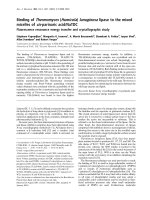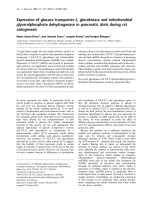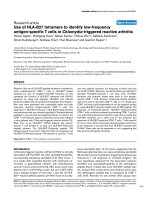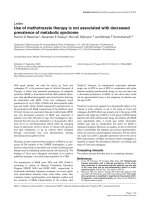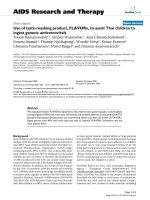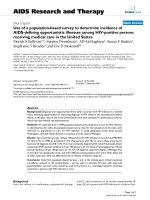Báo cáo y học: "Use of minimally invasive hemodynamic monitoring to assess dynamic changes in cardiac output at the bedside" potx
Bạn đang xem bản rút gọn của tài liệu. Xem và tải ngay bản đầy đủ của tài liệu tại đây (112.05 KB, 2 trang )
I read with dismay the Commentary by Lester Critchley
[1] on our recent pulse contour analysis study [2]. We
disagree with his statement that, based on our data, one
cannot use arterial pulse contour to assess changes in
cardiac output (CO). We compared several commercially
available arterial pulse contour methods of measuring
CO with themselves and pulmonary artery catheter
(PAC)-derived bolus thermodilution (COtd) and
continuous CO (CCO) modes. We showed that none of
these devices trended CO changes well when compared
to the others, either separately or compared to a pooled
CO value of all the devices. us, clinical trials using CO
trending data from one device cannot be extrapolated to
similar outcomes using other devices. Dr Critchley
concluded that none of the pulse contour devices
accurately trend CO changes. If that logic were true, then
one could also not use PAC CO trending either, as it fared
worse than the rest when compared to pooled CO values.
Lack of proof of CO trending correlation amongst
devices does not equate to lack of ability to trend CO by a
device. His argument is based on four lines of reasoning
that we dispute.
First, he argued that we pooled PAC COtd and CCO
measures. However, we also reported separate Bland-
Altman analyses for COtd and CCO and the relations
were unchanged. Second, we then restricted our analysis
to low fl ow states and all devices markedly improved
their CO estimates, but the concordance remained poor
compared to PAC. Furthermore, his study [3] as a refer-
ence used COtd as cardiac index (CItd) ‘giving concor-
dance across devices of 90-95% when exclusion criteria of
0.5-1.0 l/min/m
2
are applied.’ We set our exclusion limits
at 0.25 l/minute/m
2
, but if we set it at 1 l/minute/m
2
the
PiCCO, LiDCO and FloTrac concordance would increase
to 83%, 88% and 74% in line with that reported by de
Wilde and colleagues [4] using a more accurate PAC
COtd reference method. ird, the FloTrac algorithm we
used would remain the same even in the newer version of
their software. Finally, he correctly says that the site of
measure may aff ect refl ected arterial pressure waves. But
all measures with all devices for a given subject were
made from the same site. So this is a non-issue.
Accordingly, the conclusion that these devices are
inaccurate cannot be made from our study.
© 2010 BioMed Central Ltd
Use of minimally invasive hemodynamic
monitoring to assess dynamic changes in cardiac
output at the bedside
Michael R Pinsky*
See related research by Hadian et al., , and related commentary by Critchley,
/>LETTER
Author’s response
Lester AH Critchley
My recent commentary published in Critical Care [1] is a
fair refl ection of Hadian and colleagues’ paper [2], but
also the current status of pulse contour monitoring
technology. However, Dr Pinsky’s group should receive
due credit for attempting to show something that is very
diffi cult clinically, and also presenting their far from
simple data clearly. However, even with my trained eye I
still fi nd it hard to draw any positive conclusions other
than LiDCO against PAC has the least error. I also fail to
fi nd any convincing evidence that trending exists.
Dr Pinsky defends his corner with a number of argu-
ments about misinterpretation of their data analysis. e
use of CCO rather than single COtd as the reference
standard was mentioned in my commentary because it is
creeping into validation studies. In Squara and colleagues’
recent and excellent review on ‘tracking changes in
*Correspondence:
Professor of Critical Care Medicine, 606 Scaife Hall, 3550 Terrace Street, Pittsburgh,
PA 15261, USA
Pinsky Critical Care 2011, 15:406
/>© 2011 BioMed Central Ltd
cardiac output’ they discuss at length the problems of
response time when using the continuous method [5]. Dr
Pinsky refers in his letter to a paper by de Wilde and
colleagues [4], which has a particularly interesting fi gure
and Table 3 that compares fi ve pulse contour algorithms
to COtd. e two best performers are model fl ow and the
Hemac. ese methods’ concordance rates were both
96%, indicating good trending ability, unlike the LiDCO
and PiCCO cohorts, which were 88% and 84%, respec-
tively. us, there are better algorithms around for
modeling peripheral circulatory changes, so why are they
not being used?
Abbreviations
CCO, continuous cardiac output; CO, cardiac output; COtd, bolus
thermodilution cardiac output; PAC, pulmonary artery catheter.
Competing interests
MRP has received funding from Edwards LifeSciences, Inc, and LiDCO, Ltd, and
has shares with LiDCO, Ltd. MRP is also inventor of a University of Pittsburgh-
owned patent on the “Use of aortic pulse pressure and ow in bedside
hemodynamic management”.
Published: 7 March 2011
References
1. Critchley LAH: Pulse contour analysis: Is it able to reliably detect changes in
cardiac output in the hemodynamically unstable patient? Crit Care 2011,
15:106.
2. Hadian M, Kim HK, Severyn DA, Pinsky MR: Cross-comparison of cardiac
output trending accuracy of LiDCO, PiCCO, FloTrac and pulmonary artery
catheters. Crit Care 2010, 14:R212.
3. Bianco ore G, Critchley LA, Lee A, Bindi L, Bisà M, Esposito M, Meacci L, Mozzo
R, DeSimone P, Urbani L, Filipponi F: Evaluation of an uncalibrated arterial
pulse contour cardiac output monitoring system in cirrhotic patients
undergoing liver surgery. Br J Anaesth 2009, 102:47-54.
4. de Wilde RBP, Schreuder JJ, van den Berg PCM, Jansen JRC: An evaluation of
cardiac output by ve arterial pulse contour techniques during cardiac
surgery. Anaesthesia 2007, 62:760-768.
5. Squara P, Cecconi M, Rhodes A, Singer M, Chiche JD: Tracking changes in
cardiac output: methodological considerations for the validation of
monitoring devices. Intensive Care Med 2009, 35:1801-1808.
doi:10.1186/cc10024
Cite this article as: Pinsky MR: Use of minimally invasive hemodynamic
monitoring to assess dynamic changes in cardiac output at the bedside.
Critical Care 2011, 15:406.
Pinsky Critical Care 2011, 15:406
/>Page 2 of 2


